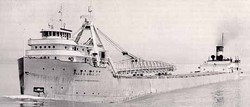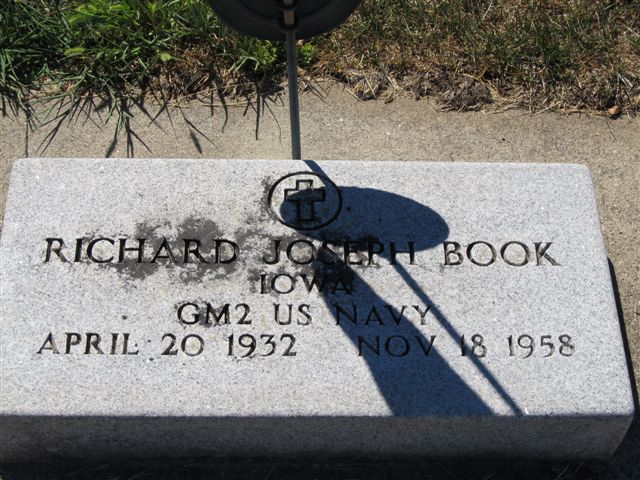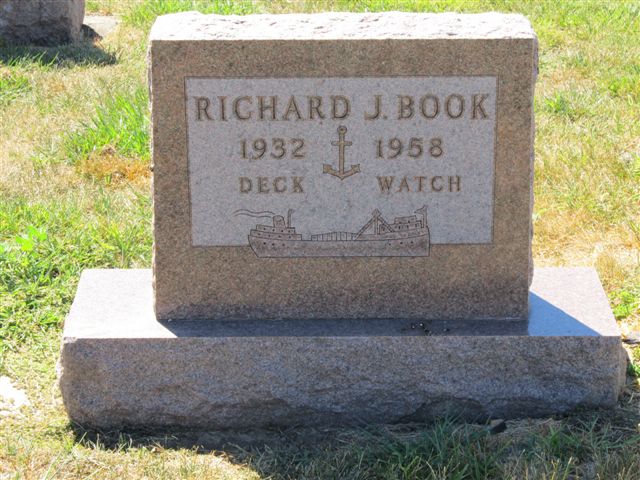Died of drowning in Lake Michigan when the ship, Carl D. Bradley sunk.
The Bradley Transportation Company of Rogers City, Michigan, had the largest self-unloading steel steamer on the Great Lakes built in 1927 and named her CARL D. BRADLEY after the President and Director of the firm. She served in the limestone and coal trades her entire career on the inland seas and set many cargo records in the process. The self-unloading type freighter was not rare on the Lakes at that time. That type of carrier had been in existence since the turn of the century but it had been perfected in the BRADLEY. She was by far the largest carrier on the Lakes at that time as well as being the largest self-unloader. It was a proud day for the citizens of Rogers City when she first steamed into port on her maiden voyage. The majority of her crew were from that small Northern Michigan port and the ship proved her worth to her owners over the next quarter century of her existence. Her days of service came to an end in a violent storm on Lake Michigan on November 18, 1958. She had left the lower Lake Michigan port of Gary bound for Rogers City in ballast and was buffeted by gale force winds almost immediately after her departure. Heavy seas washed over the bow but the BRADLEY held course towards the northern part of the Lake. At approximately 5:30 that evening she broke in two and sank almost immediately off Gull Island.
Just before going down she had sent out distress signals which were heard by the Coast Guard and a German motor vessel in the vicinity. Both the motor vessel and a US Coast Guard cutter rushed to the position last broadcast and began the search for survivors. Only two men were rescued from the thirty-five crewmen aboard. This was the most severe loss of life on Lake Michigan since the violent gales of the Armistice Day Storms of November 11, 1940. Later investigations and televised photos of her wreck on the bottom of the lake proved the BRADLEY had split in two before she sank. The mighty ship had suffered so severely from the huge seas in the last hours of her existence that she buckled and plunged to the bottom in only a few minutes. Thus ended another career of a gallant ship and the lives of her captain and crew. The city of Rogers City was overwhelmed with grief. Most of the crewmen were residents of that small town and almost every family was involved. The entire Great Lakes community was shocked at the loss of the BRADLEY and the stories of her final days in service and of the bereaved town circulated for many weeks there- after. In these days of extreme care for the safety of ships and men, the story of the BRADLEY could hardly be believed.
Died of drowning in Lake Michigan when the ship, Carl D. Bradley sunk.
The Bradley Transportation Company of Rogers City, Michigan, had the largest self-unloading steel steamer on the Great Lakes built in 1927 and named her CARL D. BRADLEY after the President and Director of the firm. She served in the limestone and coal trades her entire career on the inland seas and set many cargo records in the process. The self-unloading type freighter was not rare on the Lakes at that time. That type of carrier had been in existence since the turn of the century but it had been perfected in the BRADLEY. She was by far the largest carrier on the Lakes at that time as well as being the largest self-unloader. It was a proud day for the citizens of Rogers City when she first steamed into port on her maiden voyage. The majority of her crew were from that small Northern Michigan port and the ship proved her worth to her owners over the next quarter century of her existence. Her days of service came to an end in a violent storm on Lake Michigan on November 18, 1958. She had left the lower Lake Michigan port of Gary bound for Rogers City in ballast and was buffeted by gale force winds almost immediately after her departure. Heavy seas washed over the bow but the BRADLEY held course towards the northern part of the Lake. At approximately 5:30 that evening she broke in two and sank almost immediately off Gull Island.
Just before going down she had sent out distress signals which were heard by the Coast Guard and a German motor vessel in the vicinity. Both the motor vessel and a US Coast Guard cutter rushed to the position last broadcast and began the search for survivors. Only two men were rescued from the thirty-five crewmen aboard. This was the most severe loss of life on Lake Michigan since the violent gales of the Armistice Day Storms of November 11, 1940. Later investigations and televised photos of her wreck on the bottom of the lake proved the BRADLEY had split in two before she sank. The mighty ship had suffered so severely from the huge seas in the last hours of her existence that she buckled and plunged to the bottom in only a few minutes. Thus ended another career of a gallant ship and the lives of her captain and crew. The city of Rogers City was overwhelmed with grief. Most of the crewmen were residents of that small town and almost every family was involved. The entire Great Lakes community was shocked at the loss of the BRADLEY and the stories of her final days in service and of the bereaved town circulated for many weeks there- after. In these days of extreme care for the safety of ships and men, the story of the BRADLEY could hardly be believed.
Family Members
Sponsored by Ancestry
Advertisement
Advertisement
















